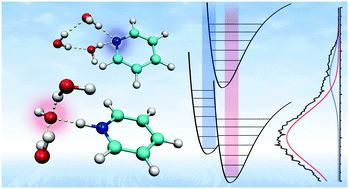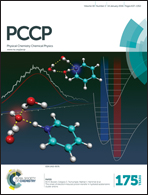The onset of electron-induced proton-transfer in hydrated azabenzene cluster anions†
Abstract
The prospect that protons from water may be transferred to N-heterocyclic molecules due to the presence of an excess electron is studied in hydrated azabenzene cluster anions using anion photoelectron spectroscopy and computational chemistry. In the case of s-triazine (C3H3N3), which has a positive adiabatic electron affinity, proton transfer is not energetically favored nor observed experimentally. Heterocyclic rings with only 1 or 2 nitrogen atoms have negative electron affinities, but the addition of solvating water molecules can yield stable negative ions. In the case of the diazines (C4H4N2: pyrazine, pyrimidine, and pyridazine) the addition of one water molecule is enough to stabilize the negative ion, with the majority of the excess electron density in a π* orbital of the heterocycle but not significantly extended over the hydrogen bonded water network. Pyridine (C5H5N), with the most negative electron affinity, requires three water molecules to stabilize its negative ion. Although our computations suggest proton transfer to be energetically viable in all five N-heterocyclic systems studied here when three or more water molecules are present, proton transfer is not observed experimentally in the triazine nor in the diazine series. In pyridine, however, proton transfer competes energetically with hydrogen bonding (solvation), when three water molecules are present, i.e., both motifs are observed. Pyridine clusters containing four or more water molecules almost exclusively exhibit proton transfer along with solvated [C6−xH6−x+1Nx·OH]− ions.


 Please wait while we load your content...
Please wait while we load your content...